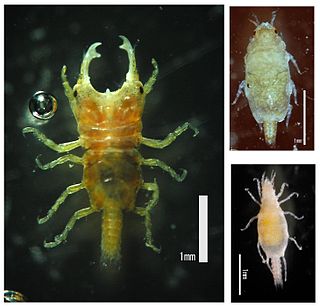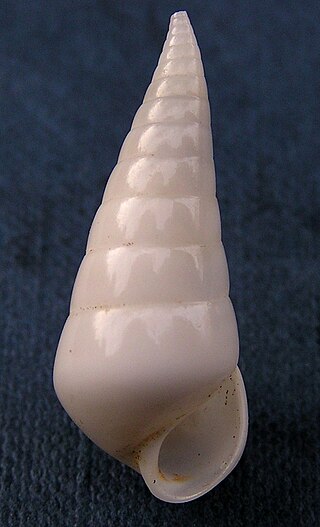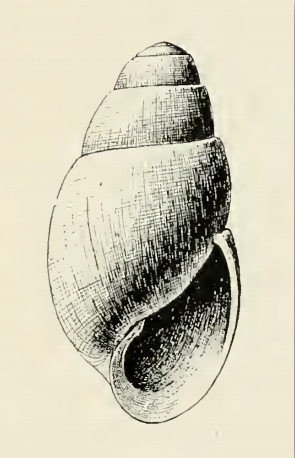
Copepods are a group of small crustaceans found in nearly every freshwater and saltwater habitat. Some species are planktonic, some are benthic, a number of species have parasitic phases, and some continental species may live in limnoterrestrial habitats and other wet terrestrial places, such as swamps, under leaf fall in wet forests, bogs, springs, ephemeral ponds, puddles, damp moss, or water-filled recesses of plants (phytotelmata) such as bromeliads and pitcher plants. Many live underground in marine and freshwater caves, sinkholes, or stream beds. Copepods are sometimes used as biodiversity indicators.

Amphipoda is an order of malacostracan crustaceans with no carapace and generally with laterally compressed bodies. Amphipods range in size from 1 to 340 millimetres and are mostly detritivores or scavengers. There are more than 9,900 amphipod species so far described. They are mostly marine animals, but are found in almost all aquatic environments. Some 1,900 species live in fresh water, and the order also includes the terrestrial sandhoppers such as Talitrus saltator and Arcitalitrus sylvaticus.

Isopoda is an order of crustacean, which includes woodlice and their relatives. Members of this group are called Isopods and include both terrestrial and aquatic species. All have rigid, segmented exoskeletons, two pairs of antennae, seven pairs of jointed limbs on the thorax, and five pairs of branching appendages on the abdomen that are used in respiration. Females brood their young in a pouch under their thorax.

The Gnathiidae are a family of isopod crustaceans. They occur in a wide range of depths, from the littoral zone to the deep sea. The adults are associated with sponges and may not feed. The juvenile form is known as a 'praniza', and it is a temporary parasite of marine fish. These forms are not larvae; Gnathiidae instead become parasitic during the manca stage. Mancae of the Gnathiidae closely resemble the adult form, however they lack the final pair of pereiopods.

Eulimidae is a family of very small parasitic sea snails, marine gastropod mollusks in the superfamily Vanikoroidea.

Worms are many different distantly related bilateral animals that typically have a long cylindrical tube-like body, no limbs, and no eyes.

Odostomia is the most speciose genus of minute sea snails, pyramidellid gastropod mollusks. This genus is placed in the family Pyramidellidae in the subfamily Odostomiinae. There are several hundred species in this diverse genus

Like humans and other animals, fish suffer from diseases and parasites. Fish defences against disease are specific and non-specific. Non-specific defences include skin and scales, as well as the mucus layer secreted by the epidermis that traps microorganisms and inhibits their growth. If pathogens breach these defences, fish can develop inflammatory responses that increase the flow of blood to infected areas and deliver white blood cells that attempt to destroy the pathogens.

Ocinebrina edwardsii is a species of sea snail, a marine gastropod mollusk in the family Muricidae, the murex snails or rock snails.

Entoconcha is a genus of very small parasitic sea snails, marine gastropod mollusks in the family Eulimidae.
Enteroxenos is a genus of very small parasitic sea snails, marine gastropod mollusks in the family Eulimidae.

Niso is a genus of very small parasitic sea snails, marine gastropod mollusks or micromollusks in the family Eulimidae.

Aartsenia is a genus of sea snails, marine gastropod mollusks in the family Pyramidellidae, the pyrams and their allies.
Odostomia kuiperi is a species of sea snail, a marine gastropod mollusc in the family Pyramidellidae, the pyrams and their allies.

Eulima bilineata is a species of sea snail, a marine gastropod mollusk in the family Eulimidae. The species is one of a number within the genus Eulima.

Eulima glabra is a species of small parasitic sea snail, a marine gastropod mollusk in the family Eulimidae. The species is one of a number within the genus Eulima.

Fuscapex is a genus of sea snails, marine gastropod mollusks in the family Eulimidae.

Hypermastus orstomi is a species of sea snail, a marine gastropod mollusk in the family Eulimidae.

Adna is a genus of acorn barnacles that grows in association with or semi-parasitically on corals and octocorals. Its only species is Adna anglica. It is found in the intertidal zone on the coasts of northwestern Europe and in the Mediterranean Sea.

Myra fugax is a species of crabs in the family Leucosiidae.


















